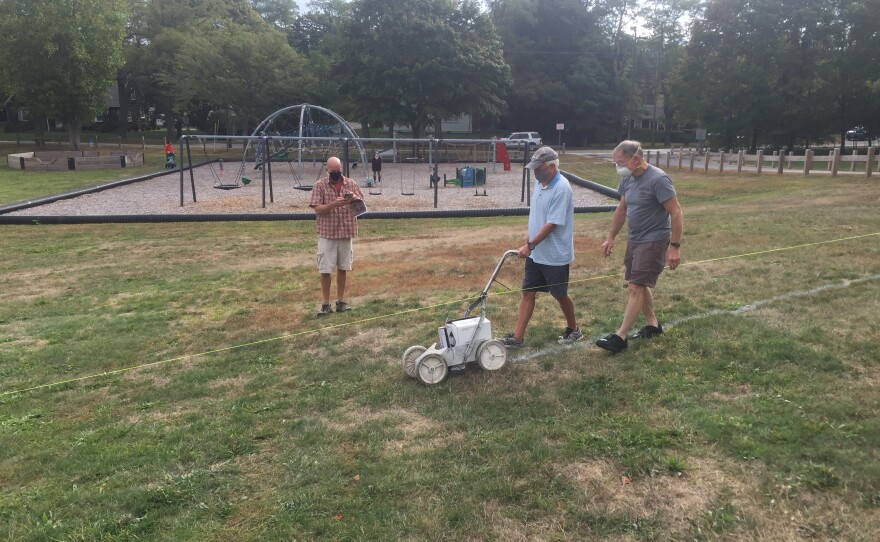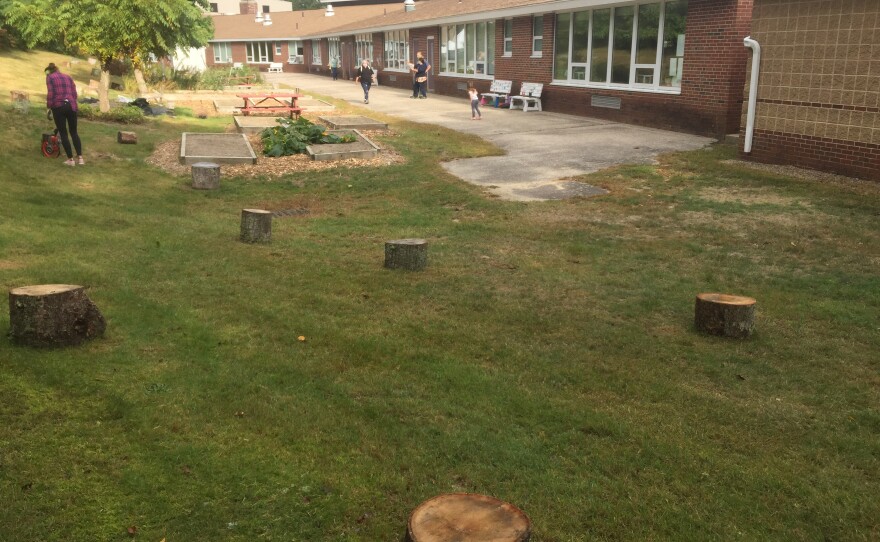A small group of parents and school staff got up early enough on a recent Saturday to make it to North Falmouth Elementary by 8:30 a.m.
They came for a morning of work, setting up outdoor spaces for kids to play and learn.
In this most unusual of years, when COVID-19 has prompted classes to spend more time out in the fresh air, some schools are taking the idea a step further by building outdoor classrooms.
Coffee in hand and toddler in tow, Falmouth parent Amy Leonardi was one of the leaders of a crew volunteering in North Falmouth. Out behind the school, she directed volunteers as they set up logs to serve as chairs.
Every class will have its own area, with seats spaced apart for physical distancing.
Leonardi said that pandemic or not, the value of time outdoors is clear.
“It's better for your mental health,” she said. “We knew, academically, that studies have shown that children do do better outside in learning environments. It teaches them self-confidence, responsibility. It stimulates creativity.”
This parent-led effort began as part of the superintendent’s reopening committee. The committee discussed the public health recommendation that social interaction take place outside, and Leonardi suggested outdoor classrooms.
With the superintendent’s blessing, she formed her own subcommittee, and the group lost no time recruiting outside support from the Rotary Club and Volunteers in Public Schools.
“And we got rolling, and we just started saying, ‘OK, how do we do this on such a massive scale?’” she said. “Because it's never been done in the public-school sector before, to this extent. And so it is — it's a massive undertaking.”
All seven Falmouth public schools are participating in ways that work for them.
Parents have drummed up donations of cash and supplies, including outdoor whiteboards for teachers. Volunteers are sewing seat cushions. And big wooden spools from electrical cable will serve as teachers’ tables.
Leonardi said that in a sense, they want to give back to children something the pandemic has taken away.
“You have that sense of normalcy,” she said. “You can take off your mask. You can speak to your friends and see their mouths, see their body language better.”
Normalcy has been hard to find this fall for just about everyone.
Over in Dennis, Holly Harrington selected in-person learning for her three daughters, who attend the Monomoy district through school choice.
She said she’s happy with the decision now, but she did worry over the summer about what it would be like for her youngest, who is in kindergarten.
“I was really worried about what that would look like, how they would manage keeping the kids apart and wearing masks,” she said.
In Monomoy, as in Falmouth, going outside is part of the plan.
“You have to bring a towel so that they can use it to sit outside,” she said. “They're doing some classrooms outside, as well as lunch and snack, just to give the kids a break, I think, from the masks.”
At the Waldorf School, which just moved to Sandwich, students spent plenty of time outside even before the pandemic, with two or three recesses a day, plus a movement class and gardening.
Now they’re learning their other subjects outside, too.
“There are tents in our big field behind the school, and they're beautiful,” said Emily Holmgren, the school business manager.
Every class has either a tent or a dome structure.
“And they're out there the whole day,” she said. “They have desks in there, and chairs, and cubbies, and they have handwashing stations, and water, drinking water, everything they need — chalkboards, all of that.”
Back in North Falmouth, the sound of hammering in the field in front of the elementary school is a reminder that none of this is really normal. During the volunteer work day, half a dozen men drove stakes into the grass to mark where they would paint white lines, like on a sports field, to prevent classes from mingling with one another during the pandemic.
Principal Tim Adams carried a map of the school grounds, divided into color-coded sections.
“And so the work we're going to do today is laying out each of the areas into sort of subsections, so teachers know where they can bring students for recess, outdoor breaks, outdoor classroom space,” he said.
Two parallel lines create a 10-foot buffer zone between spaces. Crossing the line means someone is getting too close to another class — another reminder that physical separation is central to COVID-19 prevention efforts.
Adams said the good news is, the schools are developing outdoor learning spaces they’ve wanted for a long time. And those could last long beyond the pandemic.
“So these areas will still be here for years, that we can have ... our complete grounds now become classrooms,” he said.













